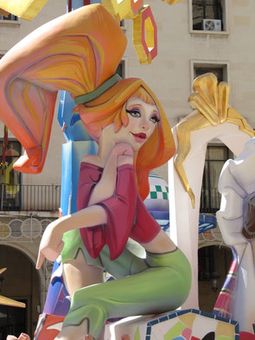PODCAST: read and listen to this entry at the same time (you can find the Spanish text here)
With the arrival of June, the people of Alicante celebrate with lots of passion and parties “Les fogueres (1) de Sant Joan”.
The “Hogueras de San Juan” (in Spanish) are the most popular festivities we celebrate in the town of Alicante. The main days of celebration are from June 20 to June 24, and everyone awaits them with eagerness and joy. This year they have been suspended due to Covid-19 but I’m sure we’ll be able to celebrate them next year again.
In this text I would like to explain to you four traditions which form part of this celebration: el ninot, la mascletà (2), la cremà (3) and la coca amb tonyina. But first we’re going to talk about the differences between Fallas and Hogueras.
Are they the same as the Fallas of Valencia?

They are similar, but not the same. The Hogueras de San Juan remind of the Fallas of Valencia but there are differences between the two. First, in Alicante they are celebrated in summer on the day of the summer solstice. While some customs are identical, others are very different.
What are the hogueras?
As you can see in the picture, hogueras are sculptures made out of wood and cardboard, amongst others. They’re always painted in very bright colors and they critically address issues that have been of concern throughout the year.
First tradition: What is el ninot?
All hogueras consist of characters. There are two kinds of hogueras: hogueras adultas and hogueras infantiles. The first ones are bigger, and the latter, smaller ones are intended for children. During the celebrations the public can vote for one of the “ninots” figures (muñeco in valenciano) to be saved from the fire. The ninots that have been saved are brought to the Hogueras Museum of Alicante, where they’re on display. If you travel to Alicante, you can visit this museum and learn more things about this celebration and what the sculptures of hogueras are like.
Second tradition: la mascletà
The “mascletà” is one of the daily must-attend events for the fireworks enthusiasts of Alicante. Every day at noon, you can enjoy this pyrotechnic show.
The mascletàs are unique and typical for the Region of Valencia. What makes them distinct is that they don’t show lights and colors like in normal fireworks. Instead, they consist of a sequence of sounds that increase little by little until they’ve reached the maximum after about 5 minutes.
The mascletàs exist outside the hogueras as well. During other important events, mascletàs are a traditional way to celebrate joy. People outside our region usually think that we are crazy, but in the Region of Valencia, the mascletàs inspire passion with their deafening noise, the smell of gunpowder and smoke.
Third tradition: la cremà
The festivities always end with the burning of the hogueras so you can start again the following year. This is done on the day of “la cremà”. At 12 o’clock midnight we begin to burn the first hoguera. Typically, it’s the one that stands in front of the town hall and it’s ignited with a big firecracker. One after the other, all hogueras of the whole city of Alicante are burned down. Firefighters refresh the audience by showering them with water so they can resist the heat of the fire. This is the traditional “banyà”.
Fourth tradition: coca amb tonyina
This last tradition is of the gastronomic kind. Festivities always have a traditional dish that’s related to them and for hogueras it’s very typical to prepare and eat coca amb tonyina. This coca is very similar to an empanada (savory turnover) and is filled with ventresca (meat from the belly of the tuna). This coca is delicious and is eaten cold. It’s a dish you can find in any racó (4) or barraca (5) in Alicante and it cannot be missing on the day of the plantà (6). I’ll give you the recipe another time.
Hogueras are very fun celebrations, they take place mostly in the streets, and they’re not short of music and fire. If you should pass by Alicante one summer between June 20 and 24 you have the chance to enjoy some special days.
Note about the text
You probably noticed that many terms in this small article are not in Spanish but in Valenciano. Valenciano is the second official language in the Region of Valencia, in which Alicante is located. Although Spanish (or Castilian) is the most commonly used language in Alicante, a lot of Valenciano terms are used on a daily basis, especially when talking about festivities, traditions or gastronomy.
Vocabulary of the festivities
- Foguera: su nombre en castellano es hoguera. Es una escultura hecha en gran parte de madera.
- Mascletà: espectáculo pirotécnico de gran sonido que se realiza durante el día. Típico de la Comunidad Valenciana.
- Cremà: es valenciano y viene del verbo quemar. Es el día en el que se queman las hogueras.
- Racò: es valenciano y describe el lugar donde se juntan para comer, cenar y bailar un grupo de gente durante las fiestas. Suele pertenecer a una Hoguera. El racò está cerrado y hay música y mesas. Cualquier persona puede formar parte de un racò pagando una cuota para esos días de fiesta.
- Barraca: son asociaciones de personas que se juntan para comer, cenar y celebrar las fiestas. Se paga una cuota anual para formar parte de una barraca. La barraca es solo para socios y hay música y mesas donde festejar. Durante el año también realizan otras actividades relacionadas con las Hogueras.
- Plantà: es el momento en el que se montan las hogueras en la calle. Dura de uno a varios días.
Credits:
Featured image: dl Spanish lessons
Picture 01: dl Spanish lessons
